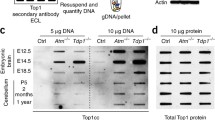Abstract.
The cells of an ataxia-oculomotor apraxia type 1 (AOA1) patient, homozygous for a new aprataxin mutation (T739C), were treated with camptothecin, an inhibitor of DNA topoisomerase I which induces DNA single-strand breaks. DNA damage was evaluated by cytogenetic analysis of chromosomal aberrations. The results obtained showed marked and dose-related increases in induced chromosomal aberrations in the patient and her heterozygous mother compared to the intrafamilial wild-type control. The alkaline comet assay confirmed this pattern. Moreover, the AOA1 cells did not show hypersensitivity to ionizing radiation, i.e. X-rays. These findings clearly indicate the direct involvement of aprataxin in the DNA single-strand-break repair machinery.
Similar content being viewed by others
Author information
Authors and Affiliations
Corresponding author
Additional information
Received 6 October 2004; received after revision 24 November 2004; accepted 28 December 2004
P. Mosesso and M. Piane contributed equally to this work.
Rights and permissions
About this article
Cite this article
Mosesso, P., Piane, M., Palitti, F. et al. The novel human gene aprataxin is directly involved in DNA single-strand-break repair. CMLS, Cell. Mol. Life Sci. 62, 485–491 (2005). https://doi.org/10.1007/s00018-004-4441-0
Issue Date:
DOI: https://doi.org/10.1007/s00018-004-4441-0




